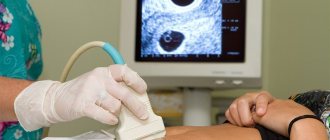When is ultrasound diagnostics prescribed?
Ultrasound of the pelvic organs in women is prescribed when there is a high probability of inflammatory pathologies, pain in the lower abdomen, discharge and problems with menstruation. Examination is also mandatory for pregnant women, which allows monitoring the process of fetal development.
Pelvic ultrasound successfully detects:
- Inflammatory processes - endometritis, endocervicitis.
- Malignant neoplasms - cancer of the uterus or ovaries.
- Disturbances in the development of the uterus.
- Pathologies that cause problems with urination.
- Causes of infertility.
- Benign neoplasms – endometriosis, cysts, fibroids, polyps.
During the examination, the location of the uterus, its shape, size and wall thickness are studied. The condition of the ovaries and the correctness of their work are determined, the presence of tumors and fluid in the abdominal cavity is checked.
Pathologies
During an ultrasound diagnosis of the female reproductive system, the doctor may encounter the following pathologies.
Uterine fibroids
If there have been hormonal disorders in the female body, then a myomatous node (or several) ranging in size from 2-3 mm to 50 cm can form from the muscular layer of the uterus. Ultrasound is indispensable in determining the number of nodes, their exact location and growth dynamics.
Hyperplasia and endometrial polyps
Hyperplasia in medicine refers to the pathological proliferation of endometrial tissue, which can be focal or diffuse in nature. In the first phase of the cycle, the thickness of the endometrium exceeds 7 mm.
What does a polyp look like?
Focal hyperplasia is characterized by the formation of polyps in areas with a changed structure. They can be multiple and reach sizes of several cm. Ultrasound diagnostics allows not only to timely identify and evaluate all pathological conditions in the female reproductive sphere, but also to select the appropriate treatment.
The procedure also helps to identify such pathologies as endometriosis.
Ovarian cysts and tumors
Cysts are divided into two groups: pathological and functional. The latter do not require medicinal intervention, as they arise and disappear on their own. But pathological cystic formations require not only control, but also treatment.
Important! Detection of an ovarian tumor requires additional diagnostics and close attention, since the tumor can be malignant.
That is why, when a neoplasm is detected in the ovary, the interpretation of the ultrasound can be carried out by a whole council of doctors.
Apoplexy or ovarian rupture
A dangerous condition that can occur spontaneously, for example due to injury. Ultrasound diagnostics allows you to assess the amount of bleeding, as well as differentiate apoplexy from ectopic pregnancy and appendicitis.
Tuboovarian formations - hydrosalpinxes
They are formed during inflammation in the pelvic organs and can not only be detected on ultrasound, but also eliminated by hydroturbation of obstructed areas of the fallopian tubes. The procedure is carried out under ultrasound control.
Pathologies associated with pregnancy
These include miscarriage, hydatidiform mole, and ectopic pregnancy.
Reference! Modern medical standards require mandatory examination of the uterus using ultrasound after childbirth, cesarean section or abortion.
The fact is that a remnant of the placenta may be discovered, which will need to be urgently removed, otherwise it will pose a threat to the woman’s life.
Pathologies of the structure of the uterus (bicornuate uterus)
This pathology is a consequence of a violation of the formation of the patient’s body in its intrauterine stage. A bicornuate uterus can cause infertility and miscarriages, bleeding outside the menstrual cycle and other gynecological problems.
In the image below you can see what a bicornuate and saddle uterus looks like.
On ultrasound, a bicornuate uterus is defined as an organ whose cavity is divided into two sections. Usually this pathology is accompanied by a number of characteristic concomitant anomalies.
How is an ultrasound performed?
Ultrasound is performed using two methods: transvaginal and abdominal. If the examination is performed on a virgin, the procedure is carried out superficially. The patient exposes the lower abdomen and lies on the couch. The doctor coats the sensor with a special gel that improves signal conductivity, and then moves the device over the surface of the abdomen.
If a woman is sexually active, transvaginal ultrasound is used.
To do this, the subject is exposed from the waist down and lies on a couch with her legs spread wide apart. A transducer, the diameter of which does not exceed 3 cm, is inserted into the vagina. For hygienic reasons, a condom is put on it, which the subjects bring with them.
The procedure lasts from 5 to 20 minutes, which depends on individual characteristics and the presence of pathologies. All information is sent to the monitor and then decrypted by a specialist.
How do they do it?
Transabdominal sensors are mainly used for the procedure .
Sometimes rectal probes may be used, and ultrasound may also be performed through the perineum.
Teenage girls who are sexually active may have a transvaginal scan.
To do this, you need to obtain written consent from their parents .
If a girl’s hymen is not broken, then such manipulation is partially replaced by transperineal examination , through the perineum.
Examination of the pelvis of girls using ultrasound diagnostics contributes to the early detection of changes in the genital organs.
Monitoring should be carried out from birth until puberty.
Transvaginal ultrasound diagnostics
The size of the uterus is normal in women, the location of the organ, the thickness of the endometrium and the location of the ovaries can be most accurately identified by transvaginal diagnosis. To do this, the sensor, which is a plastic rod 12 cm long, is inserted to a shallow depth.
The process does not cause any inconvenience, since a special gel is used, and the diameter of the device is only 3 cm. Due to the small thickness of the vaginal walls, any, even minor changes can be detected. Thanks to this, it is possible to establish an accurate diagnosis and select timely treatment.
You can find out whether the size of the uterus in women is normal using a transvaginal ultrasound.
This type of diagnosis does not require special preparation. Before the procedure, you must refrain from taking any liquid for 1 hour. It is advisable to go and empty your bladder before the examination, as the doctor usually asks you to do. If you have problems with digestion and increased gas formation, take Smecta or other drugs that normalize intestinal function.
Ultrasound examination and preparation for it
In order for the ultrasound protocol to reflect the most reliable information about the state of health of the reproductive system, a woman needs to carefully consider the process of preparing for this diagnostic procedure.
- It is better to plan the study on days 5-7 of the menstrual cycle;
- 3 days in advance it is necessary to stop eating foods that cause fermentation and gas formation in order to avoid data distortion;
- It would be useful to take a sorbent or a means to eliminate the manifestations of flatulence (for example, Espumisan);
- An hour before the procedure, drink up to 1 liter of still water to fill the bladder.
It is acceptable to perform ultrasound diagnostics during menstruation. In order to draw conclusions about the functioning of the genital organs, it is necessary to carry out the diagnosis several times at different phases of follicle maturation, for example, on days 10, 15 and 24. In different cycles, the sizes of the right and left ovaries vary depending on which side the egg matures on.
In some cases, the diagnostician cannot detect the ovary with ultrasound. The reasons may be both obvious and unexpected for the patient:
- bloating;
- adhesions in the pelvic area;
- premature organ depletion;
- removal of an organ during surgery;
- congenital absence of an ovary.
Regular monitoring of women's health will help prevent the development of diseases that lead to disruption of the reproductive and endocrine functions of the genital organs. Doctors recommend ultrasound examination of the pelvic organs twice a year or more often if there is a suspicion of pathology.
Transabdominal ultrasound diagnostics
Transabdominal ultrasound is used in virgins and is performed through the abdominal wall. To obtain accurate information, it is necessary to fill the bladder, for which the girl drinks about 1 liter of water. It is possible to use this type of examination as an addition to transvaginal diagnostics.
The gynecologist also refers pregnant women to transabdominal ultrasound if indicated.
The patient is placed on her back and the abdomen is released. The gel is applied to the surface of the skin, and then the sensor is passed onto the lower part of the peritoneum, lightly pressing it towards the body. This technique often produces errors due to the great distance from the organs being studied, especially if you are overweight or have increased gas formation.
Ultrasound methods
There are two options for ultrasound wave research: transvaginal and transabdominal methods. Through the anterior wall of the abdomen - this is an abdominal method, it is suitable for the pelvic organs. But due to the structural features of the body or in very obese people, its results may be unreliable.
The transvaginal method is considered more accurate, but is not suitable for examining virgin girls, since the gynecologist performs the examination by inserting a narrow sensor into the vagina. For examination in order to clarify the timing of ovulation and the dominant follicle, the state of the endometrium of the uterine cavity, both methods are suitable, but the abdominal one is preferable. Both are used to examine the condition of the cervix, but the vaginal sensor produces a clearer image. Both methods are absolutely painless; sensations can come from the insertion of the body into the uterine cavity or from the gel that is used to lubricate the surface of the skin during examination through the abdomen.
The norm for examining the uterus using ultrasound in women of childbearing age and postmenopause
The normal size of the uterus in women differs depending on age, number of pregnancies, abortions and hormonal levels. Specialists measure the length and width of the uterus and indicate the thickness of the walls.
Women of childbearing age have a uterus of the following sizes:
- length – up to 70 mm;
- width – up to 60 mm;
- thickness – up to 42 mm.
If a woman has not given birth or become pregnant, the length of the uterus is 47 mm; in those who have given birth, the figures increase to 61 mm. Moreover, with each pregnancy the length of the uterus and its width increase. When there were pregnancies, but without childbirth, the length of the organ will be within 54 mm.
To obtain accurate results, it is recommended to do an ultrasound on days 5-8 of the cycle, and repeat examinations at the same phase. The conclusion may be affected by hormonal fluctuations, the presence of pregnancies and childbirth. Sometimes even stress and nervous overload lead to changes in size.
During menopause, the production of female sex hormones decreases, which causes a decrease in the size of the uterus. At the beginning of postmenopause, the length of the uterus varies from 40 to 70 mm, width - 27-54 mm, and wall thickness - 18-36 mm. 15-30 years after the start of changes, the length of the uterus will be 33-67 mm, width - 25-54, wall thickness - 14-36.
Sizes can vary greatly, as it all depends on the time of onset of menopause and the individual characteristics of the body. For some women, menopause begins before the age of 40, and for others it occurs after 60. If the indicators do not differ much from the norm at the time of the onset of menopause, there is a high probability of becoming pregnant through artificial insemination.
Sizes during pregnancy
When pregnancy occurs, great changes occur in a woman’s body and, first of all, the uterus begins to enlarge. At the very beginning of pregnancy, the size of the organ remains within normal limits.
But, as the fetus grows, the uterus begins to increase and, according to the gestational age in weeks, its parameters change, that is, the height of the uterine fundus:
- 4-8 – the size of the organ corresponds to a goose egg;
- 12 – the uterus is at the level of the symphysis pubis;
- 16 – in the middle between the navel and the womb;
- 20 – 2 fingers below the navel;
- 24 – at the level of the navel;
- 28 – above the navel by 2 fingers width;
- 32 – in the middle between the navel and the xiphoid process;
- 38 – at the level of the sternum;
- 40 – midway between the sternum and the navel, which begins to protrude before childbirth.
On ultrasound, changes in the uterus during pregnancy are clearly identified, which makes it possible to monitor the development of the fetus.
Body position
The uterus is located between the bladder and rectum. It moves slightly when the urinary or intestinal tract is very full, as well as during pregnancy. Normally, the body of the uterus faces anteriorly, which is called anteversion.
When the body of the uterus rotates towards the lateral wall of the pelvis, they speak of lateroversion, and a posterior displacement indicates retroversion.
Flexion, or bending of the uterus, also occurs, which leads to painful menstruation and discomfort during sexual intercourse. With a slight bend, a woman easily becomes pregnant, and after childbirth the uterus returns to its normal position. If the pathology is severe, difficulties with conception are possible.
Prevention of uterine diseases
To prevent illness, it is better to take care of your health right away. It is necessary to carry out prevention, which consists of certain actions. Every woman needs to do them.
Even minor measures will help prevent the development of a serious disease. In some cases, preventive measures improve intimate life.
To take care of your health you need:
- Visit a gynecologist once a year. Take the necessary tests to detect bacterial microflora of the vagina and other examinations.
- Visit a mammologist once a year. You can observe the mammary glands on your own from the first day of your period.
- It is important for a woman to have sexual relations . During sexual intercourse, more blood begins to flow into the uterus.
- For adult women, it is necessary to do special exercises to strengthen the vaginal muscles.
- You should pay attention to genital hygiene , especially during sexual intercourse.
- When the menstrual cycle begins, it is necessary to take more care than usual about the cleanliness of the genitals.
- You need to ensure timely emptying of the bladder ; if you hold back, the position of the uterus may change.
- It is necessary to maintain proper nutrition , which is dominated by vegetables, fruits and other foods containing vitamins and macroelements.
- You should keep yourself in shape and exercise, but not overwork as much as possible.
Each woman has individual indicators of the normal size of the uterus. However, they are usually rounded and often have minor deviations.
Endometrial size
The endometrium includes two layers - basal and functional, which are sensitive to the effects of hormones. The functional layer peels off, which causes menstruation. By the end of menstruation, the endometrium becomes thin, and after ovulation its thickness is maximum. During this period, the woman’s body prepares for pregnancy. If it does not occur, the cycle repeats from the beginning.
Because of this feature, the examination takes into account the phase of the cycle:
- The beginning of the cycle with discharge. On the 3-4th day of the cycle, the thickness of the endometrium is 3-5 mm, and its gradual restoration occurs.
- Proliferation is the middle part of the cycle. On days 5-7 of the cycle, the thickness is 6-9 mm, and by day 10 it reaches 1 cm. At week 2 the parameters can reach 1.3 cm.
- Secretion is the completion of the cycle. By the 18th day of the cycle, the thickness reaches 1-1.6 cm, and by the 20-23rd day the parameters are maximum - 1-2.1 cm. Then there is a gradual decrease in size to 1-1.8 cm.
Upon reaching menopause, the production of sex hormones decreases, and the reproductive system gradually reduces its functionality.
After 45-50 years, women often develop pathological processes, so it is imperative to undergo preventive examinations. The permissible dimensions of the endometrium are 5 mm. If the readings reach 8 mm, diagnostic curettage is performed.
There are two types of endometrial pathologies: hyperplasia and hypoplasia. Hyperplasia is characterized by the growth of the endometrium with a significant increase in its thickness. This process often accompanies the following disorders: fibroids, endometriosis. During menopause, such changes indicate inflammatory diseases.
Hypoplasia is manifested by thinning of the endometrium, which does not depend on the stage of the cycle. This pathology develops against the background of poor local blood supply, chronic endometritis, or problems with estrogen production.
Normal echographic picture
Interpretation of ultrasound of the pelvic organs in women begins with measuring the size of the uterus. The length, defined as the distance from the fundus of the uterus to the internal os of the cervix, should be 5–8 cm. The average length in healthy nulliparous women should be in the range of 6.0–7.1 cm. In women who have given birth to one child, there is a slight increase uterine body, more pronounced after several births.
The anterior-posterior size (thickness) of the uterus should normally be within 3–4 cm, and the transverse size (width) should be 4.5–6.0 cm. After several years after the decline of reproductive function, it is permissible to reduce the size of the uterus to 4 –5 cm
An important factor taken into account when assessing the condition of the female reproductive organs is the position of the uterus
Normally, it is located in the central part of the small pelvis, deviating towards the anterior abdominal wall. This situation in the examination protocol is designated by the term “anteflexio”. The term “retroflexio” refers to a physiological disturbance in the position of the uterine body caused by its deviation back, that is, “bending”, and “lateroflexio” means a displacement of the uterus relative to the central axis of the body.
Important! When assessing the position of the uterus, it should be taken into account that a full bladder causes some deviation from its normal position. Ultrasound image: uterus on day 19 of the menstrual cycle
The length of the uterine body (number 1) is 57.6 mm, the width (number 2) is 42.9 mm, the width of the uterine cavity (number 3) is 7.1 mm
An ultrasound image shows the uterus on the 19th day of the menstrual cycle. The length of the uterine body (number 1) is 57.6 mm, the width (number 2) is 42.9 mm, the width of the uterine cavity (number 3) is 7.1 mm
The cervix on an echogram is defined as a 2–3-centimeter formation, cylindrical in shape, with echogenicity indistinguishable from the uterus. The width of the cervical canal should be between 3–4 mm. When examined by ultrasound, the ovaries appear as oval formations located on both sides of the uterus. The normal length of the ovaries should be 2.7–3.7 cm, width 2.1–2.9 cm, and anterior-posterior dimension – 1.7–2.1 cm.
In general, the size of the ovaries can vary within quite a wide range, since during the growth of the follicles the ovary enlarges. After the isolation of the dominant follicle, which is determined in the first phase of the cycle in the form of a small formation (0.5–1.3 cm), which continues to grow actively until the 12–14th day of the menstrual cycle, the rest decrease again, and the ovary acquires normal size.
By the day of ovulation, the follicle can reach 1.5–2.9 cm in size and can be clearly identified on ultrasound. By visual assessment, the size of one ovary should not exceed half the width of the uterine body. Normally, fallopian tubes are not visible on ultrasound. Immediately after ovulation, the formation of the corpus luteum, a temporary hormone-producing gland, begins, the main purpose of which is to ensure implantation of the embryo and maintain pregnancy.
The corpus luteum appears to be a small formation with heterogeneous thick walls and liquid contents. The entry in the ultrasound examination protocol “corpus luteum cyst” is assessed based on the timing of the diagnosis, since detection of a cyst after ovulation indicates normal functioning of the reproductive system, and before ovulation – a pathological formation.
The endometrial layer in the uterine cavity in the first days of the menstrual cycle is defined as a heterogeneous structure of varying thickness (from 0.3 to 0.8 cm). By the time menstrual bleeding ends (4–5 days of the cycle), the thickness of the endometrial layer is only 0.2–0.4 cm and is practically invisible on the echogram. In the early phase of proliferation (day 6–7 of the cycle), a slight thickening of the endometrium up to 0.6–0.9 cm can be noticed, with a simultaneous decrease in echogenicity.
At the same time, its layering is clearly determined in the form of the appearance of a thin echo-negative contour 1 mm thick. By day 10, the thickness of the endometrial layer is about 1 cm. In the secretory phase (days 15–27 of the cycle), as well as during menstrual bleeding, a significant thickening of the endometrium occurs (sometimes up to 1.5 cm), which is noted on the echogram in the form of a thickened reflective surface internal cavity of the uterus.
Important! Detection of the corpus luteum and thickened endometrium at the beginning of the menstrual cycle, in the absence of a fertilized egg in the uterine cavity, can serve as an indirect sign of ectopic pregnancy. Ultrasound image: uterus on day 25 of the menstrual cycle
The thickness of the endometrial layer is 1.0 cm
An ultrasound image shows the uterus on the 25th day of the menstrual cycle. The thickness of the endometrial layer is 1.0 cm
Uterus size
The size of the uterus in women according to ultrasound is calculated taking into account age, number of pregnancies and births. Normally, immediately after birth in girls, the length of the uterus is 30-40 mm, and its width does not exceed 15 mm. Such parameters are explained by the influence of maternal sex hormones, the influence of which gradually weakens.
By 2-4 years, the total length of the uterus does not exceed 33 mm. Then each year the length increases by 2-3 mm, reaching a total length of 8.2 cm by the age of 17. The body of the uterus will have a length of 53 mm, a width of 51, and a thickness of 37 mm.
The indicators are slightly different for women of childbearing age, when puberty is completed:
| Women category | Length | Width | Thickness |
| No pregnancies | 47 | 50 | 35 |
| With pregnancies, but without childbirth | 54 | 55 | 38 |
| Those who gave birth | 61 | 60 | 42 |
During the climatic period, the parameters change, and the uterus becomes smaller. Specific numbers depend on the production of sex hormones, the age of the woman and the timing of the onset of menopause.
At the beginning of menopause, the size of the uterus is almost no different from that of women of childbearing age. By the end of menopause, the characteristics are much smaller, but only a gynecologist can make a specific conclusion about the appropriateness of the uterus for age.
Reasons for deviations in ovarian size from normal
If an ultrasound reveals a significant enlargement of the ovary, then we can talk about the presence of the following pathologies:
- Ovarian cyst . In this case, a cavity filled with liquid is determined. The cyst can be of different sizes. Single or multiple formations (polycystic) may be detected. This pathology is dangerous due to its complications (cyst rupture, cyst pedicle torsion), which require emergency care and surgical treatment;
- Benign neoplasms;
- Malignant neoplasms. With timely detection, stable remission and cure can be achieved;
- Metastases . In this case, a formation is detected that is a metastasis of cancer of any location;
- Congenital pathologies of the ovarian structure.
Ultrasound of the ovaries in women can also reveal a shrinkage of the ovary . Particular attention should be paid to such changes in women of childbearing age. In this case, premature menopause develops, that is, the woman’s menstrual function gradually fades away. This can be observed in women between 35 and 40 years old.
Presence of free fluid
Normally, there is no fluid in the pelvis, but sometimes a small amount is acceptable. It indicates recent ovulation, during which the contents of the follicle entered the area behind the uterus.
If the fluid does not disappear even a few days after ovulation, the following pathologies can be suspected:
- Endometriosis.
- Inflammation of the pelvic organs - ruptured cysts, purulent salpitis, acute endometritis.
- Ascites is the accumulation of fluid in the abdominal cavity due to malignant tumors.
- Bleeding in the abdominal cavity.
- Ectopic pregnancy accompanied by rupture of the fallopian tube.
A competent doctor will detect other signs of disorders, which will allow you to correctly diagnose and select treatment.
Ultrasound examinations of the pelvis in girls and adolescents
Ultrasound scanner WS80
An ideal tool for prenatal research.
Unique image quality and a full range of diagnostic programs for an expert assessment of a woman’s health.
General provisions
The incidence of genital pathology in girls and adolescents is high. According to our data, the prevalence of dysmenorrhea in girls aged 12-18 years is 19.79. According to foreign data, up to 50% of all teenage girls experience episodes of menstrual dysfunction to one degree or another: dysfunctional uterine bleeding, dysmenorrhea, amenorrhea, premenstrual syndrome [1, 2]. The causes of these and other disorders (pain in the lower abdomen and perineal pain, disorders of puberty, palpable formations, etc.) can be a variety of diseases. Their timely detection is largely determined by visualization capabilities.
In modern conditions, non-invasive intrascopic methods are widely used: ultrasound (US), computed tomography (CT) and magnetic resonance imaging (MRI). All the more important are uniform principles for choosing a technique and clinical interpretation of the results of its use.
Ultrasound is the method of choice in pediatric and adolescent gynecology. Sedation is not required even in restless patients; preparation for the study is minimal. A filled bladder is used as an ultrasound window, which is able to push back intestinal loops distended by gases. Small children, of course, will not comply with any requests for a drink, so they must be fed (breast milk, formula) before the examination. Older girls can drink 300-500 ml of water without gas 30-45 minutes before the procedure.
To examine children in the first 3 years of life, it is necessary to use sensors with a frequency of 7.5 MHz, at older ages - 5-7.5 MHz, for adolescents - 3.5-5 MHz. Modern multi-frequency sensors allow you to vary the radiation frequency directly during the examination, choosing the optimal visualization mode.
Diagnostic capabilities are further expanded with the use of Doppler ultrasound, including color, and volumetric reconstruction. In sexually active adolescents, after written parental consent, transvaginal scanning is possible. With an intact hymen, transperineal examination can partially replace transvaginal examination.
In 20-25% of cases, abnormalities of the reproductive system are combined with abnormalities of the kidneys and distal intestine, which requires examination of these systems as well.
CT and/or MRI are indicated only if additional information is needed. In the presence of ovarian masses after ultrasound, the use of CT with an adequate protocol that minimizes the radiation dose is justified. CT can reliably identify small areas of calcification or fatty tissue that are difficult to visualize with ultrasound or MRI. MRI is preferable when the diagnosis of a tumor has already been established: the information content of the method is high, and there is no risk of ionizing radiation.
In cases of non-tumor lesions and developmental anomalies, MRI is used before CT. In addition, the choice between CT and MRI is determined by the higher cost of MRI, the need for patient sedation, and the duration of the procedure.
The development of the pelvic organs determines the ultrasound picture at different age periods and the formation of anomalies. At the 3rd week of intrauterine development, a cell strand appears along the Wolffian canal (the canal of the primary kidney, mesonephros), which gradually separates. A lumen (Müllerian canal) forms inside it. Wolffian ducts are completely reduced. Only their terminal parts are partially preserved in the form of paraurethral passages (Gartner's canals). Müllerian canals are actively developing. From their initial ends the fallopian tubes are formed. At a considerable distance, these channels merge into an unpaired duct. The wall of the latter thickens, and the duct gives rise to the uterus and the upper third of the vagina. At the 8th week, the Müllerian ducts, fused into the uterovaginal canal, reach the urogenital sinus in the Müllerian tubercle. The urogenital sinus is formed from the division of the cloaca into the rectum and urogenital sinus. At the same time, the vaginal rudiment begins to develop distally, at the 3rd month it reaches the fused Müllerian ducts, and at the 5th month the vaginal rudiment is canalized. Thus, the upper 2/3-4/5 of the vagina are formed from the fused Müllerian ducts, the lower third - from the urogenital sinus.
Anomalies in the development of the Müllerian canals and disruption of their connection with the vaginal rudiment are classified as agenesis, disorders of lateral and/or vertical fusion (Fig. 1). It is possible to form a double uterus with a double or single vagina, a bicornuate uterus (with a less severe separation they speak of a saddle-shaped uterus), and a uterus with an internal septum.
Rice. 1.
Malformation of the reproductive system. Incomplete duplication of the uterus. Rudimentary closed uterine horn on the right. Hematometra on the right. Multiple hydatid fallopian tubes. Colpitis.
At the 17th week of intrauterine development, the ovaries begin to differentiate. The process is possible only if there are two X chromosomes.
The uterus of a newborn girl is influenced by maternal hormones. The cervix is larger than its body (2:1), the length of the uterus is about 3-3.5 cm, thickness is 1-1.4 cm. A thin echogenic line of the endometrium is often visualized. There may be a small amount of fluid in the uterine cavity and vagina. At the age of 6-12 months, the influence of maternal hormones decreases and the size of the uterus and ovaries decreases [3].
In the prepubertal period, the uterus is cylindrical, the anteroposterior size of the cervix is equal to the anteroposterior size of the uterine body. The length of the uterus is 2.5-4 cm, thickness is 1 cm (Table 1). The endometrium is not always visualized and only at high resolution.
Table 1
. Length of the uterus at different age periods.
| Age, years | Uterus length, cm | ||
| percentiles | |||
| 5 | 50 | 75 | |
| Newborn | 0,5 | 2 | 3,5 |
| 1 | 1 | 2,5 | 3,8 |
| 2 | 1,8 | 2,8 | 4 |
| 4 | 1,9 | 2,8 | 4,3 |
| 6 | 1,9 | 2,8 | 4,5 |
| 8 | 1,9 | 3,1 | 4,5 |
| 10 | 2,0 | 3,4 | 4,8 |
| 12 | 4 | 4,8 | 6,5 |
| 14 | 6 | 7,5 | 8 |
During puberty, the uterus acquires the shape and size characteristic of adults. The cervix is smaller than its body (1:2-1:3). The length of the uterus is 5-8 cm, width - 3 cm, thickness - 1.5 cm. The shape of the uterus may depend on the degree of filling of the bladder. When it is full, the uterus appears flattened, and the predominance of the size of the uterine body over the size of the cervix is smoothed out. After partial emptying of the bladder, the shape of the uterus is restored, the size of the body turns out to be larger than the size of the cervix. The picture of the endometrium depends on the phase of the menstrual cycle.
The Doppler curve of the uterine artery, located during transverse scanning at the level of the uterine fundus, is an important indicator of the end of puberty. In the prepubertal period, diastolic flow is not determined. At 8-10 years of age, a low intermittent diastolic wave appears. The end of puberty is symbolized by a high, broad spectrum systolic waveform with a continuous, long diastolic signal.
The size of the ovaries is described by their volume, using the formula for the volume of an ellipse (V = 1/2 length x width x depth). The average volume of the ovaries in the 1st year is 1 cm³, in the 2nd year - 0.67 cm³. This value remains almost constant up to 6 years, not exceeding 1 cm³. In the prepubertal period (6-10 years), the volume of the ovaries fluctuates between 1.2-2.3 cm³, at 11-12 years - 2-4 cm³, after the formation of menstrual function - 2.5-20 cm³ [4].
For practical work, it is important to know that in the prepubertal period the maximum length of the uterus is 4.5 cm, the thickness of the uterus is 1 cm, and the volume of the ovaries is 4-5 cm³.
Follicles in the ovaries are visualized very early. They look like microcysts with a diameter of no more than 0.9-1.0 cm. In newborns and girls under 2 years old they can be detected in 70-85% of cases, at the age of 2-12 years - less often, only in 50-60% of those examined. Vascularization of the ovaries in infants and prepubertal girls is weak and increases from 6-8 years of age. During the same period, the medulla and cortex of the ovaries begin to differentiate. At 11-12 years of age, primordial follicles appear.
Pathological conditions
Intersex genitalia.
Signs of the syndrome may include cryptorchidism, fusion of the labia, clitoromegaly, epi- or hypospadias. The conditions are classified as female pseudohermaphroditism, male pseudohermaphroditism, and true pseudohermaphroditism. Pseudohermaphroditism (intersex genitalia syndrome) is a discrepancy between the chromosomal, gonadal or genital sex of a child. In the male version of intersex genitalia, the child has testicles; in the female version, the child has ovaries or ovarian tissue [5]. The ultrasound specialist's task is to identify the presence or absence of a uterus and the type of gonads. The study must include imaging of the kidneys and adrenal glands. Subsequently, karyotyping and examination of hormonal status are carried out (Table 2). The most common cause of intersex genital syndrome is congenital hyperplasia of the adrenal cortex (adrenogenital syndrome), transmitted in an autosomal recessive manner. A defect in 11b- or 21-hydroxylase occurs, which leads to increased accumulation of aldosterone and cortisol. The absence of a natural feedback mechanism leads to the synthesis of large amounts of adrenocorticotropic hormone and hyperplasia of adrenocortical cells. Excess of steroid precursors involves a pathological bypass pathway of androgen synthesis. As a result, the androgen-sensitive internal and external genital structures of the girl are masculinized. In severe cases, salt-wasting crises develop. The rarest causes of masculinization with a normal chromosomal complement are the intake of androgens by the mother in the early stages of pregnancy or masculinizing ovarian tumors.
table 2
. Characteristics of the most common variants of intersex genitalia syndrome.
| State | Karyotype | Causes | Phenotypic traits |
| Congenital adrenal hyperplasia (female pseudohermaphroditism) | 46 XX Genetically girl | Excess androgens of the adrenal cortex, masculinization of women | Uterus, ovaries, clitoromegaly, partial fusion of labia, urogenital sinus |
| Androgen resistance syndrome (testicular feminization) | 46 XY Genetically male | Resistance to androgens at the cellular level during the formation of sexual characteristics. There may be small formations resembling testicles. Anti-Mullerian substance activity is high, so there is no uterus | Phenotypically girl. Testicles in the abdominal cavity, inguinal canal or labia majora. No penis or scrotum. The uterus is absent or rudimentary. The vagina ends blindly. People with this syndrome are oriented as women. During puberty, female sexual characteristics develop, but there are no menstruation |
| Male pseudohermaphroditism | 46 XY Genetically male | Genetic defect in testosterone synthesis in the fetal testicles | Incomplete virilization. Vestigial or normally developed testes |
| XY gonadal dysgenesis | 46 XY Genetically male | No gonads, no testosterone. There is no anti-Mullerian substance in the prenatal period | Phenotypically girl. No ovaries. There is a uterus |
Puberty disorders.
Puberty is the time of transition of the body from childhood to adulthood (10-16 years). But already at the age of 8, biochemical changes occur, primarily in the adrenal glands (Table 3). Disorders of puberty - absence of signs, their early (premature maturation) or late appearance.
Table 3
. Main characteristics of puberty in girls.
| State | Age, years | Manifestations |
| Adrenarche | 8-10 | Prepubertal adrenal activation |
| Pubertal growth spurt | 10-13 | Begins at 10 years, maximum growth rate at 12-13 years |
| Telarche | 10-12 | Breast development |
| Pubarhe | 10-13 | Pubic hair growth |
| Menarche | 10-16 | First menstruation |
| Hair growth in the armpit | >12 |
Precocious puberty (PPP) is the development of secondary sexual characteristics in girls before the 8th year of life. Central (true) PPS is gonadotropin-dependent, identical to natural, but occurs much earlier due to pathological activation of the hypothalamic-pituitary-gonadal axis with a sharp increase in the concentration of luteinizing and follicle-stimulating hormones. It can be idiopathic (80% of all cases), congenital (with hydrocephalus), acquired (after trauma, surgery, infection, etc.), tumor (for example, microscopic hamartomas).
Sonographically, large folliculated ovaries and endometrial proliferation are detected. Doppler ultrasound is especially informative: blood flow through the uterine artery increases until the size of the uterus increases [6, 7].
False PPS is caused by a tumor of the ovaries or adrenal glands. The concentration of estrogen is increased, the concentration of luteinizing and follicle-stimulating hormones is low. Causes may include damage to the adrenal cortex (tumors), ovaries (granulosa cell tumors), and hormone intake. It is “non-synchronous”, i.e. the appearance of signs is changed in time. For example, with a tumor or congenital hyperplasia of the adrenal cortex, isolated pubic hair with virilization is recorded. False PPS develops quickly and is often combined with neurological symptoms (with neurofibromatosis). There are secondary sexual characteristics, but there is no ovulation. Ultrasound reveals large, functioning ovarian follicular cysts, so there may be transient enlargement of the mammary glands. Echographically, solid or mixed tumors are clearly differentiated. Ovarian granulosa cell tumors are most often accompanied by isosexual PPS.
Isolated premature adrenarche is the development of axillary and pubic hair without other signs of puberty. Manifestation is typical before 8 years of age in girls and 9 years of age in boys, and is more often recorded in Asians. Usually self-terminating, growth acceleration is very small. Echographically, the ovaries and uterus are not changed, although polycystic ovaries are often detected (up to 67%).
Isolated premature thelarche is isolated development of the mammary glands without the development of puberty. It is more often registered in girls aged from 2 months to 6 years, enlargement of only one gland is possible, there is no axillary and pubic hair growth, there is no acceleration of growth, it ends on its own.
Delayed puberty is less common in girls than in boys. Defined as the absence of sexual development at 14 years of age (for boys - at 15 years of age). Such children are usually short in stature. First of all, Turner syndrome and hypothyroidism should be excluded. The causes of delayed sexual development may be constitutional factors (parents of such children entered puberty late), systemic diseases with low secretion of gonadotropin (inflammatory diseases of the colon, anorexia, growth hormone deficiency, acquired hypothyroidism), diseases with high secretion of gonadotropin (Turner syndrome, Klinefelter, consequences of chemotherapy/radiotherapy). With ultrasound, in the case of constitutional delay of sexual development, the uterus and ovaries are of normal size, and there are many follicles in the ovaries. With primary gonadal insufficiency (for example, with Turner syndrome), the ovaries are small, dense with a mass of strips of connective tissue, the uterus is of prepubertal size.
Prepubertal vaginal bleeding
may be caused by premature puberty, vaginal foreign bodies, and in very rare cases, vaginal rhabdomyosarcoma. A vaginal foreign body is detected as an echo-positive linear structure, the presence of an acoustic shadow is determined by the type of foreign body and its size. Vaginal rhabdomyosarcoma, according to ultrasound, appears as a large solid echogenic, heterogeneous or hypoechoic mass behind the bladder.
Menstrual irregularities in adolescents
known as primary amenorrhea, secondary amenorrhea, dysfunctional bleeding and oligomenorrhea. It should be remembered that menstruation is the result of a complex interaction between the hypothalamus-pituitary-ovarian axis. The development of the process is slow. Up to 80% of all menstrual cycles after menarche are anovulatory.
Primary amenorrhea is considered to be the absence of menstruation (menarche) before the age of 18 (according to American data, up to 16 years) or the absence of menstruation (secondary amenorrhea) for 3 months in a girl with previously determined rhythmic episodes of vaginal bleeding. The group of primary amenorrhea should automatically include girls 15 years old without developed secondary sexual characteristics.
The causes may be Turner syndrome, Addison syndrome, adrenogenital syndrome, congenital Rothmund-Thomson poikiloderma, Swyer phenotype, adrenal and pituitary tumors with virilization, craniopharyngiomas, hypothyroidism. A rare case of primary amenorrhea with normal sexual development is Mayer-Rokitansky-Küstner syndrome (normal ovaries, absent or rudimentary uterus, vaginal atresia). The karyotype of such patients is not changed; in 33-50% of cases, renal anomalies are recorded, and in 10-12% - skeletal anomalies [8, 9].
An anatomical defect in the form of hymen aperforatum, or a violation of the natural communication between the uterus and the cervix or the cervix and the vagina (Müllerian anomaly) can cause a false-positive diagnosis of primary amenorrhea.
When diagnosing secondary amenorrhea, the doctor must first rule out pregnancy. Amenorrhea can develop after the use of hormonal contraceptives (2:1000 users), especially when they start taking them at an early age. In general, this is slightly higher than the frequency of amenorrhea in women who did not take hormonal contraceptives, but one cannot be complacent, since there is evidence that hormonal contraceptives do not act directly, but in a roundabout way by stimulating the development of prolactinoma.
Mental shock, hysteria, debilitating diseases, ill-conceived fasting courses are the causes of secondary amenorrhea, just like tumors of the central nervous system, ovaries, polycystic ovaries, gonadotropin-resistant ovaries, endometrial defects of an inflammatory or artificial (curettage) nature (post-traumatic synechiae of the uterus - Asherman's syndrome, such patients simply have nothing to menstruate with).
False amenorrhea is possible during normal puberty as a result of an obstructive Müllerian anomaly. In adolescents, vaginal obstruction is often caused by an imporforated hymen, and in rare cases by a transverse septum. The condition is manifested by periodic abdominal pain without signs of menstruation. Ultrasound reveals a fluid-filled dilated vagina (hematocolpos) and in some cases a fluid-filled uterus (hematometrocolpos). A transperineal scan reveals the transverse septum (membrane) of the vagina. Very rarely, with a double reproductive system (double uterus, obstruction of one vagina), periodic abdominal pain (hematocolpos of an abnormal vagina) is combined with normal menstruation (through an unoccluded vagina). Duplication of the reproductive system is very often combined with kidney anomalies.
One of the most common conditions leading to secondary amenorrhea or irregular menstruation is polycystic ovary syndrome (Stein-Leventhal syndrome). It should be excluded in all girls with obesity, hirsutism, acne, or type 2 diabetes in the family history. Chronic hyperestrogenic hyperandrogenic stimulation leads to chronic anovulation. Echographically, the ovaries are enlarged in size, echogenicity is increased, and the stroma is hypertrophied. There are many small immature cysts along the periphery of the ovaries. The presence of large follicles and a large ovarian cyst indicates against Stein-Leventhal syndrome.
Pregnancy is a relatively common cause of secondary amenorrhea. The frequency of teenage pregnancies in different regions of Russia is 70-90-101.7 per 1000 teenage girls [10, 11]. Teenagers often do not take into account the possibility of pregnancy and associate its manifestations with other conditions. The researcher’s task is to identify a normal pregnancy, and in the absence of intrauterine pregnancy, exclude an ectopic one. In the latter case, it is advisable to perform endovaginal sonography, the diagnostic capabilities of which are higher than transabdominal.
Abdominal pain due to gynecological diseases
may occur, for example, with hemorrhage into the follicle. The echographic picture depends on the volume of blood and the age of the patient. A hemorrhagic cyst is usually multi-chambered, with low-intensity internal echo structures, and avascular. Over time, internal blood clots are lysed, which leads to a change in the echostructure of the cyst. This sign is used for differential diagnosis. A hemorrhagic cyst usually resolves on its own over time. But if the cyst persists for several cycles, invasive diagnostic interventions are required to exclude a tumor.
Ovarian torsion is accompanied by abdominal pain and is almost always unilateral. Torsion of a healthy ovary is possible, but usually it occurs against the background of an ovarian cyst or tumor. Ovarian torsion is partial or complete rotation of the ovary relative to the vascular pedicle. Ovarian and fallopian tube torsion usually occurs in the first 20 years of life, and in this age group before menarche. This is due to the fact that the ovaries in girls are mobile, their position changes depending on intra-abdominal pressure and body position. The clinical picture may initially resemble appendicitis, as pain appears in the lower abdomen, accompanied by nausea, vomiting and leukocytosis. The echographic picture varies depending on the degree and duration of torsion, from ovarian edema to necrosis. In 70-75% of cases, a characteristic sign of torsion is detected: multiple small cysts along the periphery of the enlarged ovary. This phenomenon is explained by the transudation of fluid from the vessels. In addition, free fluid is detected in the pouch of Douglas.
Volumetric formations of the pelvis
can be of a gynecological nature, tumor or inflammatory origin.
Ovarian cysts are the most common type of space-occupying formations in newborns and infants. They are the result of pathological development of follicles due to their excessive stimulation by maternal hormones. The second peak in the detection of large ovarian cysts occurs during menarche (Fig. 2). The development of cysts requires the exclusion of specific endocrinopathies and oncology.
Rice. 2.
Paraovary cyst on the left. Hydatids of the fallopian tubes.
Ovarian cysts can be an incidental finding during a routine examination or manifest as an intraperitoneal mass formation. The most common complication of ovarian cysts is torsion of the gonads, hemorrhage into the cyst cavity, perforation, obstruction of the intestine and ureter are less common.
After puberty is completed, visualization of a physiological follicular cyst or corpus luteum cyst with a diameter of less than 3 cm is possible. With the involution of a mature follicle or corpus luteum cyst, a functional cyst is formed, the diameter of which reaches 4-10 cm. Follicular cysts are usually asymptomatic. Corpus luteum cyst manifests itself as pain in the abdomen or pelvis.
A rare cause of space-occupying lesions in the pelvic area are secondary pelvic peritoneal cysts, which form when fluid encapsulates from the ovarian follicle. The cyst may be multi-chambered. Secondary cysts are more often formed in girls who have undergone surgery or against the background of pelvic inflammatory diseases [12].
Hematocolpos can also manifest as a space-occupying formation.
Pelvic inflammatory disease (PID) is the most common complication of sexually transmitted diseases. Almost every 5 cases of PID are registered in sexually active adolescents, sharply increasing the risk of infertility, ectopic pregnancy, chronic pelvic pain syndrome and perineal pain. The most common pathogens are N. gonorrhoea, Chl. trachomatis and anaerobic endogenous flora, ascendingly affecting the fallopian tubes and ovaries. At the initial stage, the boundaries between the uterus and ovary are erased. When pus accumulates inside the fallopian tube, occlusion and pyosalpinus occur. Sonographically, a tubular structure with heterogeneous contents is visualized. The spread of infection to the ovary leads to a tubo-ovarian abscess, which may look like a solid formation. In cases of necrosis and liquefaction of the formation, a single- or multi-chamber cyst with unevenly thickened stacks is visualized. According to color Doppler scanning, hypervascularization of the inflamed ovary is recorded. Clinically, pain in the lower abdomen, fever and leukocytosis are noted. Palpation of the painful formation is possible.
Ovarian tumors are rare in children. They either appear as a space-occupying lesion or begin with an acute pain syndrome in cases of torsion, hemorrhage or rupture. 70% of all ovarian tumors in children are benign. Usually these are dermoid cysts or mature teratomas, the peak incidence is 10-15 years (Fig. 3). In 10% of all cases, teratomas affect both ovaries simultaneously or with a time interval. Echographically, they look like insufficiently homogeneous masses, hypoechoic along the periphery, with a hyperechoic focus in the center, up to the phenomenon of acoustic shadowing [13]. 10-12% of teratomas appear as hypoechoic formations. The internal structures are so small that they are not visualized echographically. In this situation, CT and MRI are more informative. Rare benign tumors in children include cystadenoma and gonadoblastoma. The latter is known as a germinoma precursor. Germinoma develops in children with gonadal dysgenesis, Turner syndrome and true hermaphroditism. Often these are bilateral tumors containing calcifications.
Rice. 3.
Large mature cystic teratoma of the right ovary. Adhesive process in the abdominal cavity.
Malignant tumors are more often registered in post-pubertal adolescents, accounting for 1-2% of the total malignoma structure. In children, 70-75% of all ovarian malignancies are germ cell tumors, such as dysgerminoma, endodermal sinus tumor, immature teratoma, embryonal carcinoma and choriocarcinoma. Epithelial and stromal tumors in children occur in 25-30% of cases.
Tumor infiltration of the ovaries is possible in leukemia, non-Hodgkin's lymphoma, neuroblastoma or adenocarcinoma of the colon.
Tumors of the vagina and uterus in children are extremely rare. They are represented by embryonal rhabdomyosarcoma, endodermal sinus tumor, clear cell carcinoma and are manifested by bloody vaginal discharge.
Conclusion
Thus, the high diagnostic value and safety of ultrasound examinations make them the method of choice for pathology of the pelvic organs in girls and adolescents. Echography allows you to reliably assess the anatomical features and hormonal status of children with intersex genitalia, premature or late puberty and appears as the first technique for the syndrome of abdominal pain, pelvic pain and in the presence of space-occupying formations in the pelvis. Computed tomography and magnetic resonance imaging are indicated to clarify the stage of the tumor process, visualize small calcifications, and finely characterize anatomical relationships.
Literature
- Braverman P., Neinstein L. Dysmenorrhea and premenstrual syndrome / Lippincott Williams & Wilkins, Philadelphia, 2003. 130 p.
- Haward M., Shafer M. Vaginitis and cervicitis / Lippincott Williams & Wilkins, Philadelphia, 2003. 90 p.
- Herter L., Golendzimer E., Flores J. et al. Ovarian and uterine sonography in healthy girls between 1 and 13 years old: correlation of findings with age and pubertal status. // American Journal of Roentgenology. 2002. V. 178. P. 1531-1536.
- Razzaghy-Azar M., Ghasemi F., Hallaji F. et al. Sonophraphic measurements of uterus and ovaries in premenacheal healthy girls between 6 and 13 years old: correlation with age and pubertal status. // Journal of Clinical ultrasound, 2010 (https://www.ncbi.nlm.nih.gov/pubmed/20572067).
- Bruyn R. Pediatric Ultrasound. How, Why and When. Churchill and Livingstone, 2005. 373 p.
- Barnewolt C. Imaging techniques to assess the pelvis in young females // Semin. Pediatr. Surg. 1998.V. 7. P. 73-81.
- States L., Bellah R. Imaging of the pediatric female pelvis // Semin. Roentgenology. 1996. V. 31. P. 312-329.
- Lang I., Babyn P., Oliver G. MR imaging of paediatric uterovaginal anomalies // Pediatric Radiology, 1999. V. 29. P. 163-170.
- Loncope Ch., Jonson Th. Amenorrhea. In: Greene H., Glassock R., Kelly M. (Eds.) Introduction to Clinical Medicine. Philadelphia, Decker Inc., 1991, pp. 195-199.
- Singh S., Darroch J. Adolescent Pregnancy and Childbearing: Levels and trends in developing countries, 1999. V. 32. P. 14-23.
- Radzinsky V.E. Contraception in adolescents // Consilium Medicum, 2002. T. 4 (Gynecology). N 6.
- Hoffer F., Kozakewich H., Colodny A., Goldstein D. Peritoneal inclusion cysts: ovarian fluid in peritoneal adhesions // Radiology. 1988. V. 169. P. 189-191.
- Adkin St. Teratomas and other germ cell tumors (https://emedicine.medscape.com/article/939938-overview). Last updated May 2008.
Ultrasound scanner WS80
An ideal tool for prenatal research.
Unique image quality and a full range of diagnostic programs for an expert assessment of a woman’s health.
Normal body size chart according to ultrasound
The normal size of the uterus in women according to ultrasound and in girls is best demonstrated by the following table:
| Age | Length of the uterus, cm | Width, cm | Anterior-posterior size, cm |
| 2-7 years | 3, 19 | 1, 5 | 0,9 |
| 8-9 | 3, 5 | 1,7 | 1,1 |
| 10-11 | 4,9 | 2 | 1,5 |
| 17-19 | 4,8 | 4,1 | 3,3 |
By the end of puberty, the body of the uterus reaches a length of 5 cm and a width of 4 cm.
In nulliparous
If a woman has never given birth or become pregnant, the length and width of her uterus is about 5 cm. After conception, which did not result in childbirth, the length increases to 5.4 cm and the width - 5.5 cm.
Those who gave birth
The normal size of the uterus in women who have given birth is significantly larger than in women who have not given birth. The parameters depend on the number of births and unsuccessful pregnancies. The more births a woman has experienced, the greater the parameters will be. On average, the length and width of the uterus are 6 cm. After several births, the numbers can increase to 7 cm.
Small value
The normal size of the cervix is subject to special control by obstetricians. Isthmic-cervical insufficiency can lead to premature birth in early pregnancy. The normal parameters of the cervix during pregnancy range from 4.5 cm in the first trimester to 3 cm in the third. With a progressive decrease in size other than normal, a diagnosis of ICI is made and treatment is prescribed with drugs that reduce the contractile activity of the uterus.
A cervical length of 2.5 cm before 36 weeks is an indication for placement of an obstetric pessary or sutures.
During pregnancy, the size of the cervix is measured using ultrasound waves. In addition to the length of the organ, the condition of the internal pharynx and cervical canal is assessed. The degree of expansion of the canal, as well as the presence of an open internal pharynx, are assessed. If the length is less than 2-2.2 cm, it is impossible to place an obstetric pessary, and the same applies to sutures.
A small cervix is treated on average from 14 to 25 weeks of pregnancy. Depending on the indications, the timing may vary.
The size of the uterus below normal in girls who have reached puberty is a possible symptom of infantilism. Hypoplasia of the uterine body is described by insufficient ultrasound parameters, which, depending on the values, are differentiated into 3 degrees.
How does the size of the uterus change with different pathologies?
The size of the uterus is affected by hormonal fluctuations and various pathologies. The most common of them are uterine fibroids, ovarian cysts and malignant tumors. Such diseases are accompanied by a significant change in the size of the uterus, disruption of the menstrual cycle, pain in the lower abdomen and frequent urination.
If the tumor reaches a large size, incontinence develops. Women complain of flatulence, weakness, difficulty conceiving and frequent miscarriages.
Less common is uterine hypoplasia, or baby uterus. In such cases, the length of the organ is from 3 to 5 cm, and there are often other changes in parameters. The pathology may be congenital or acquired. Serious stress and frequent nervous experiences can provoke a stop in the development of an organ. A woman with this diagnosis is able to give birth to a child, but after treatment.
The chances of successful conception and pregnancy depend on the degree of pathology:
- Stage 1 – adolescence. The size of the uterus is close to normal and ranges from 5.5 to 7 cm. It is easy to treat and often does not require adjustment.
- Stage 2 – childhood. The length of the uterus is 3 – 5.5 cm, the chances of bearing a child are minimal. Treatment is hormonal, long-term.
- Stage 3 – embryonic uterus. The length of the organ does not exceed 3 cm, and the cervix is often too long. It is impossible to bear and conceive a child with this degree of pathology.
The most severe form of the disease is called agenesia. Occurs in 1 woman in 4–10 thousand. It manifests itself as the complete absence of the uterus or its minimal size. The pathology is accompanied by underdevelopment of the external genitalia, which leads to pain during sex.
The disease is detected due to the absence of menstruation, and the only opportunity to have a child with this pathology is surrogacy. The size of the uterus increases significantly due to the formation of cysts and tumors. The most common pathology is uterine fibroids, which are a benign neoplasm.
It can reach enormous sizes, reducing a woman’s quality of life and causing problems with urination and bowel movements. Ovarian tumors also provoke changes in the size of the uterus, causing it to adapt to surrounding organs. In order not to miss the development of a dangerous pathology, you should know what the normal size of the uterus in women should be according to ultrasound.
If you undergo a timely examination and check all parameters for compliance with standards, you can prolong life and improve its quality. If a pathology is detected, it is necessary to do an ultrasound every six months in order to monitor the dynamics and not miss the degeneration of a benign tumor into a malignant one.
Article design: Oleg Lozinsky
Ultrasound standards during pregnancy
In general, an ultrasound examination is carried out not so much to show the unborn baby to the mother, but to assess the condition and development of the fetus, as well as to identify problems as early as possible and, if possible, eliminate them. Therefore, there are certain ultrasound standards at 19 weeks. In general, during this period a lot of various indicators are measured and evaluated. So, the weight of the fetus is determined. It is approximately 230-300 grams, and its length is about 22 centimeters. But these are not all the norms determined by ultrasound at 19 weeks.
There are many more indicators that help assess the condition of the fetus.
So, the BDP is about 41-49 millimeters, the exhaust gas is 140-180 millimeters, and the coolant is 125-155 mm. LZR is about 54-60 millimeters, DB is 25-30 mm, DG is 23-31 mm, DP is about 24-34 mm, and DPR is 20-26 mm.
The thickness of the collar zone (it should not exceed 5 mm) and the nasal bone (it is approximately 5.2 - 5.5 mm) are also measured. These are the norms for ultrasound at 19 weeks of pregnancy.
It is clear that all the abbreviations presented above are incomprehensible to many pregnant women.
How to understand an ultrasound of a pregnant woman?
Its decoding is as follows:
BDP is the biparental size (that is, the distance from one temple to the other),
- OG - girth of the head,
- AB – abdominal circumference,
- DB – thigh length,
- DG – length of the lower leg,
- DP – shoulder length,
- LPR – length of the forearm. LZR is listed in the transcript of an ultrasound of a pregnant woman as the fronto-occipital size and represents the distance from the back of the head to the forehead.
The collar zone is a fold of skin in the area of the neck of the unborn baby.
This is the transcript of an ultrasound scan of a pregnant woman.
What else does a doctor determine on an ultrasound?
The previous paragraph talked about fetal indicators. But there are other important results from the 19th week ultrasound. For example, an ultrasound specialist will evaluate the condition of the uterus.
So, if the myometrium (layer of the uterine wall) is thickened, then this may indicate hypertonicity, which is dangerous due to the threat of miscarriage. In addition, the placenta will also be examined.
In general, there are three degrees of maturity; at 19 weeks the norm is zero. Also, from the results of the 19th week ultrasound, you can learn about the quality and quantity of amniotic fluid. The doctor will find out whether there is polyhydramnios or oligohydramnios, and also whether there are suspensions in the amniotic fluid. The umbilical cord will be assessed.
Normally, it should have 3 vessels, namely 2 veins and 1 artery. Among other things, a routine ultrasound of pregnant women will also reveal the position of the fetus in the uterus: transverse, oblique, longitudinal or unstable. These are the results of an ultrasound at 19 weeks of pregnancy.
Why was this research needed and what to do with the results?
It, as already mentioned, is prescribed to assess the condition of the fetus and uterus. The expectant mother should submit the ultrasound protocol of a pregnant woman (indicators with transcripts) to the antenatal clinic, the gynecologist with whom she is being observed. He will study everything carefully.
By the way, the data from the pregnant woman’s ultrasound protocol will be transferred to the maternity hospital along with the exchange card, so that the doctor delivering the baby can find out and assess the risks and dangers and take the necessary measures in a timely manner.
If, during a routine ultrasound of pregnant women, an uzist suspects some kind of pathology, then, most likely, he will refer the expectant mother to a specialist.
It is worth understanding this point: in order for the data of the ultrasound protocol of pregnant women to be correct, it is important that the research apparatus itself is new and modern. In addition, the qualifications and professionalism of the ultrasound specialist are no less important.
Therefore, it is best to think in advance about conducting a routine ultrasound of pregnant women. And don’t be scared if the doctor sees something wrong
In addition, the qualifications and professionalism of the ultrasound specialist are no less important. Therefore, it is best to think in advance about conducting a routine ultrasound of pregnant women. And don’t be afraid if the doctor sees something wrong.
First, the data must be confirmed.
Secondly, with the current capabilities of modern medicine, many problems and pathologies can be eliminated even before the baby is born.
It only remains to add that ultrasound diagnostics is an extremely important study, so the expectant mother must undergo it within the time frame specified by the doctor.











